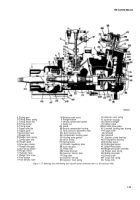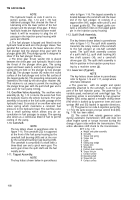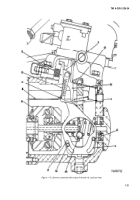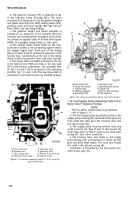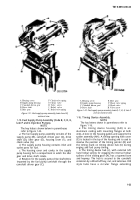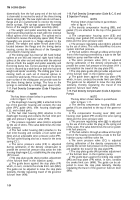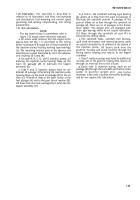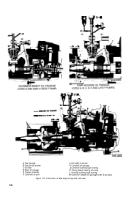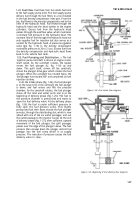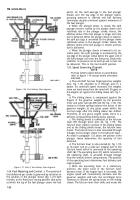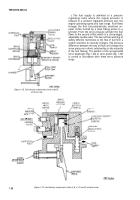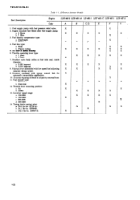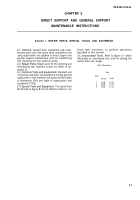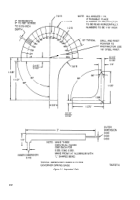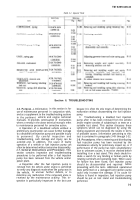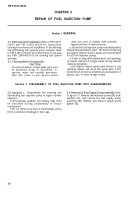TM-9-2910-226-34 - Page 37 of 208
TM 9-2910-226-34
plunger sleeve toward increased fuel delivery. The
engine then increases to original speed.
-
f.
If engine load is decreased, the speed will
momentarily increase and the governor weights will
move further out. The fingers on the weights shift
the sliding sleeve against the opposing spring forces.
The fulcrum lever shifts and moves the plunger
sleeve toward decreased fuel delivery, reducing
engine speed.
g. The operating shaft is connected to the fulcrum
lever by the shaft spring plate (C) and operating
shaft spring (D). The fork on the upper portion of the
shaft spring plate engages the fulcrum lever. The
operating shaft spring grips the tang on the spring
plate and the tang on the operating shaft. This
torsion spring loads both tangs toward each other so
that normally the operating lever and fulcrum lever
act as though rigidly attached. When engine speed
differs as a result of load changes, from the normal to
the operating lever position, the tangs part
momentarily until the governor senses the change.
This function protects
-
the governor and fuel in-
jection pump parts from unnecessary high loads and
stresses.
NOTE
The key letters shown below in parentheses
refer to figure 1-18.
The functioning of the torque link assembly applies
only to code A-injection pumps. As the torque link
(D) moves upward, the fuel stop wedge (F) moves
upward to an increased fuel delivery. ‘As it moves
downward the fuel delivery decreases.
h.
The principle function of the torque link
assembly is to control the sliding stop wedge (F) and
its movement up and down. Due to its wedge con-
figuration, as it moves up it moves the stop plate (H)
forward allowing the smoke limit cam (G) to move to
an increased fuel position. As it moves downward it
moves the stop plate toward the rear of governor
housing or a decreased fuel position. The torque link
assembly limits maximum fuel quantity at any
position of the operating shaft assembly other than
the full-load position or low-idle position of the
operating shaft assembly.
i.
When the operating shaft assembly is in the
full-load position the torque link assembly is in the
full-load quantity position. Pin (K) has contacted
surface (L) of kidney slot and raised the torque link
assembly to its maximum upward travel position.
As the operating shaft assembly is moved away from
the full-load position the torque link assembly moves
downward resulting in decreased fuel. At an in-
termediate operating shaft position, the spring (C)
moves stop wedge (F) downward to a position where
both pins
-
come in contact with the torque link
assembly. This position represents maximum fuel
limiting effect. In the low-idle position, pin (N) has
contacted surface (P), and raised the torque link
assembly. This provides maximum fuel delivery for
engine starting. The purpose of above operations is
to protect the engine and automatic transmission
from excessive load changes during shifting, while
maintaining power at full load and providing suf-
ficient starting fuel quantities.
1-26. Timing Advancement.
NOTE
The key letters shown below in parentheses
refer to figure 1-16.
As the engine speed rotates the weight and spider
assembly (AH),
centrifugal force opens the
flyweights from. their collapsed position. The loading
of the three timing device springs (B) acts against
the flyweights until a certain engine speed is
reached, at which point the forces of springs and
flyweights are balanced. As engine speed increases,
the flyweights swing out and force the sliding gear
(A) toward the timing device hub (C). As a result of
this longitudinal and axial movement of the sliding
gear, the metering and distributing pump camshaft
is rotated slightly out of phase and in advance of the
weight and spider. The axial movement of the sliding
gear is caused by the internal helical splines of the
sliding gear acting on the external helical splines of
the weight and spider and the timing device hub
(para 1-16). Therefore, the timing of the fuel pump
with relation to the top dead center position of the
engine’s piston is advanced within a given range.
1-27. Fuel Density Compensating (Typical).
a.
The
multifuel engine operates on fuels having a
significant variation in density and heat value per
gallon. These variations in the fuels affect engine
output. Any power loss due to a change of fuel is not
acceptable. The fuel density compensator on the fuel
injection pump automatically varies the quantity of
fuel delivered to the engine to maintain a constant
maximum power output regardless of the fuel being
used.
b.
The characteristics of the fuels used in the en-
gine show a definite relationship between viscosity
and heating value. The fuel density compensator
takes this into consideration by making the viscosity
characteristic a sensed variable. In the compensator
the fuel is passed in series through two orificies of
widely different flow characterist its. A change in
viscosity of the fuel flowing through these orifices
causes a pressure drop change which moves a servo
diaphragm (fig. 1-28) or piston (fig. 1-29) to vary the
full-load stop of the fuel injection pump.
1-29
Back to Top

